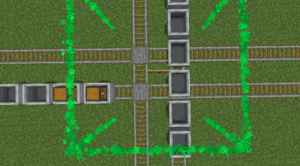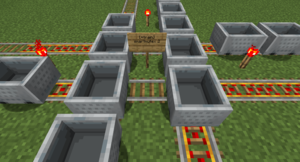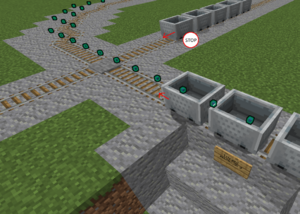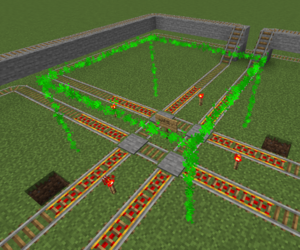//Mutex
介绍
闭塞区间处理:当一列车已经进入闭塞区间,其他列车将不能驶入。闭塞区间清空后,其他列车才能驶入。闭塞区间与转辙器结合使用,可避免列车相撞。当闭塞区间存在列车时,底座连接的拉杆会被切换为开启状态。
可通过将多个闭塞区间命名为相同的名称来进行组合,从而组建形状复杂的闭塞区间。
语法
- 第一行:[train](不需要激活)。
- 第二行:mutex,通过简单设置参数,比如 1x2x1(分别表示 x/y/z),即可创建一个长方体闭塞区间。当后面只跟着一个整数值时,该数值会一次性设置长方体的 x/y/z 半径值(以控制牌控制的铁轨为中心的半径)。当后面跟着两个整数值时,第一个数值设置长方体的 x/z 半径值,第二个数值设置长方体的 y 半径值。使用三个数值,分别设置长方体的 x/y/z 半径值。
- 第三行:名称(可选),多个相同名称的闭塞区间可组合形成更大更复杂的闭塞区间。
- 第四行:语句(可选),每个相同名称的控制牌都会添加到语句列表中。在前面添加“&”或“|”来表示“和”与“或”。
智能闭塞区间
智能闭塞区间会检测列车通过区间的路线,允许路线不互相影响的列车通过。这允许多列车同时穿过交叉路口,前提是路线不会互相影响。
Prediction
When checking the path a train will take through the smart mutex zone, switchers are taken into account. The current switched state of the rails is then not important.
Pathing Mutex
The pathing mutex attempts to replace the waiter sign in a more reliable fashion. When trains activate the pathing mutex sign, a path is predicted that the train will take from that point. All rails visited along this path become part of a temporary mutex zone. Other trains are blocked from entering this path, and if a train is already on it, the train is stopped in front of the pathing mutex sign.
Syntax
pathmutex / pmutex: Creates a standard mutex zone using the path ahead
spmutex: Creates a smart mutex zone using the path ahead
First number is the path distance ahead to create as a mutex zone. Second number (optional) sets the width, or, distance that trains keep from the path. Setting this to a higher number avoids trains colliding with each other.
Slowing down on approach
By setting the train wait acceleration property, trains will automatically slow down approaching an occupied mutex zone, instead of stopping instantly.




